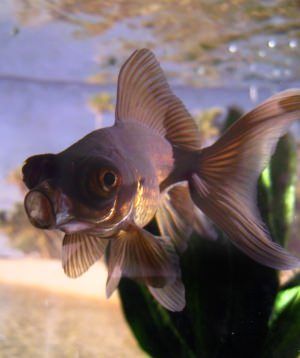
What’s the most important thing about a goldfish environment? It’s not the food, not the lighting, and not even that little diver with the treasure chest (though he does make for hours of entertainment).
You guessed it. It’s water!
Just like the air that fills your lungs, water supplies goldfish with essential oxygen. Without fresh and clean water, your goldfish can get sick. And if the water is filled with harmful toxins, there’s a slim chance your goldfish will survive.
After all, how long could you last if every breath set your lungs on fire?
If you plop your goldfish into tap water without treating tap water for goldfish first, stress could be the least of their problems. In fact, chlorine and heavy metals in the tap water can literally kill your goldfish overnight!
What’s wrong with using fresh tap water for goldfish?
Let’s go behind the scenes, taking a look at what could happen when goldfish meet tap water.
What’s in the Tap? Unraveling the Goldfish and Tap Water Mystery
Fresh tap water looks crystal clear, so it must be safe for goldfish right?
Not quite!
Invisible toxic substances that may be floating around in your tap water can be dangerous – even deadly – to your goldfish!
The culprits? Chemicals and heavy metals.
Chlorine and Chloramine: Goldfish Poison in Disguise
There’s a chance your tap water contains chlorine, a chemical that fights off nasty bacteria that could make you, me, and everyone you know sick if it weren’t for the chlorine keeping it in line.
Sometimes tap water is also disinfected with chloramine, basically a chlorine/ammonia combination that works overtime to make tap water safe to drink – for humans!
The problem is, goldfish can’t stand chlorine.
While a small amount of chlorine is bad for goldfish, the added ammonia in chloramine makes tap water even worse!
Chlorine and chloramine are completely invisible to the naked eye – you can’t see them but your goldfish will feel them. If you drop your goldfish directly into tap water containing chlorine, this damaging chemical will burn their gills and this gill damage can make it hard for your goldfish to breathe.
Not only can chlorine destroy the beneficial bacteria that keeps your aquarium water healthy, but it will eventually kill your goldfish if the tap water isn’t treated.
Heavy Metal Chemistry: Not a Rock Band
In addition to chemicals, tap water also contains heavy metals like cadmium, copper, lead, and zinc. While humans tolerate this without trouble, goldfish are very sensitive to most heavy metals.
Yes, goldfish do need small amounts of some heavy metals (zinc, for example). But if zinc concentrations are high, the overload can do more harm than help – damaging the gills and posing a life-threatening risk.
Goldfish are even less tolerant to lead and copper. Depending on your water source, these heavy metals can be abundant in large quantities!
Keeping Tap Water Safe for Goldfish: The Healthy Water Treatment
Goldfish can tell right away when they’ve been placed in dangerous tap water. They’ll frantically gasp for breath, rush to the water surface, and sometimes might attempt to jump right out of the water.
The worst news?
If you use tap water for goldfish that contains harmful chemicals or high amounts of metals (and leave it untreated), your goldfish won’t have long to live – at all. At most, your goldfish might survive until the early morning.
Don’t take any chances.
To make tap water safe for goldfish, you have to remove both chlorine-based disinfectants and heavy metals in the water. That’s when tap water conditioners come into play, neutralizing chlorine and getting rid of excess heavy metals that cause goldfish stress.
In a hostile environment, water conditioners are vital for keeping tap water for goldfish safe.
Plus, some water conditioners even include powerful stress coat boosters that help your goldfish fight off nasty goldfish diseases.
The Friendly Water Conditioner: Treating Tap Water for Goldfish
Before every water change, always treat tap water with a water conditioner.
With such a variety of water conditioners available, I don’t know a single pet store that doesn’t carry one. Some water conditioners only act as a dechlorinator (and just remove chlorine) while others completely condition your aquarium water – making tap water safe for goldfish, not only from chlorine but heavy metals as well!
Some water districts use chloramine in place of chlorine and others use both chloramine and chlorine. Treating chloramine will only neutralize the chlorine, leaving toxic ammonia behind.
Play it safe and always buy a conditioner that neutralizes both chlorine and chloramine, making tap water for goldfish safe the second it enters the water.
These three water conditioners (below) are great stand-alone conditioners and do a remarkable job treating tap water for goldfish. I’ve personally tried and recommend them.
- API Stress Coat helps stressed out goldfish recover faster by replacing the slime coat lost during infection and healing damaged tissue while it’s at it – all while neutralizing chlorine, removing chloramines, and detoxifying heavy metals in tap water.
- Tetra AquaSafe Plus makes tap water safe for goldfish by neutralizing chlorine, chloramines, and heavy metals while adding vitamins and minerals to the water. This conditioner also helps wounded goldfish rebuild their slime coats and boosts the growth of beneficial bacteria (essential for keeping your aquarium water healthy).
- Seachem Prime removes chlorine and chloramine in tap water, converting harmful ammonia into a safe, non-toxic substance. Prime also neutralizes nitrite and nitrate while detoxifying heavy metals in aquarium water, promoting a healthy slime coat to boot! Because Prime is highly concentrated, it’s a good option for large aquariums.
After choosing a water conditioner, you don’t need anything else to keep tap water for goldfish safe.
I use Seachem Prime in all of my tanks (because it’s concentrated) but I had used Tetra AquaSafe for over 8 years before switching to Prime. I recommend API Stress Coat when you’re treating goldfish diseases or after buying new fish (that could be stressed from handling).
When you treat tap water for goldfish, make sure to carefully follow the instructions on the bottle. As you mix the solution, your goldfish should be safe in conditioned water until the water conditioner has finished work.
Pre-Conditioned Water, a Tap Water Alternative
You can forgo the tap water altogether and buy special pre-conditioned water from a pet store.
Bottled pre-conditioned water is designed to make water changes as easy as possible. Simply twist off the bottle cap and pour the water directly into your aquarium.
Unlike the water you drink from plastic bottles (which you should never use in your aquarium), pre-conditioned water is teaming with important minerals – without the chemical risk of tap water. Some of the water is even oxygenated, which can be useful if you’re concerned that your water may not be getting enough oxygen exposure from its surface.
But when faced with large water changes (consequences of messy goldfish) and even larger aquarium sizes, oxygenated pre-conditioned water from the pet store can get pricey quickly. That’s why they’re usually designed for betta bowls instead.
Besides, water conditioners work just fine. And really, they’re all you’ll ever need.
Either way, you can rest assured that your goldfish will remain safe and happy – and that’s what matters.
Forgot the Water Conditioner? Make Tap Water for Goldfish Safe
Even if you accidentally put goldfish in tap water and you notice your goldfish acting strangely, you might still be able to save them in time.

Act quickly!
Immediately treat the aquarium with a water conditioner, following the directions on the back of the container.
If there’s chlorine in the tap water, it probably already destroyed most of the beneficial bacteria in your aquarium filter. Move your goldfish to a cycled aquarium if possible until your established tank can complete the nitrogen cycle again.
At this point, the gills might already be damaged. Add an air stone to increase aeration (you’ll need airline tubing and an air pump for this). The air stone will boost oxygen levels in the water, making it easier for your goldfish to breathe.
If you ever suspect there might be a trace of chlorine or chloramine in the aquarium water, never leave it overnight! Treat tap water for goldfish quickly and your fish might have a fighting chance.
Always provide your goldfish with the highest quality water possible, complete with routine water changes and excellent mechanical/biological filtration. By treating harmful chemicals in tap water, your goldfish can live a long and healthy life.
Your Turn: How Do You Treat Tap Water for Goldfish?
Do you have a favorite water conditioner? What products do you use to keep tap water for goldfish safe?
Share your tap water stories in the comments below!



